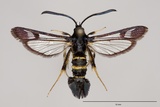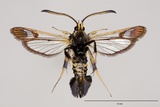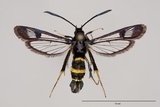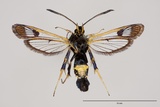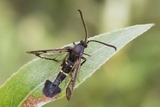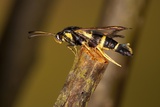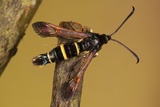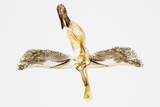Synanthedon flaviventris (Staudinger, 1883) Species
Last modified: May 14, 2024, 10:28 a.m.
A local species, restricted to the southern part of Belgium, where it was first recorded in 1999 (LX). Later, it was also discovered in the southeastern part (LG).
Details
- Classification
- Family: Sesiidae > Subfamily: Sesiinae > Tribus: Synanthedonini > Genus: Synanthedon > Species: Synanthedon flaviventris
- Vernacular names
- Geelbuikwespvlinder (NL), Sallow Clearwing (EN), Sésie jaune-gorge (FR), Weidengallen-Glasflügler (DE)
- First mention in Belgium
- Garrevoet T. & Garrevoet W. 2000. Synanthedon flaviventris, een nieuwe soort voor de Belgische fauna (Lepidoptera: Sesiidae). — Phegea 28(4): 153–154. On page 153. view page
- Status
-
Native
Distribution
Imago
S. flaviventris is a rather small species (12–21 mm) with, as the name indicates, a yellow belly. Also the very narrow external transparent area on the forewing is also characteristic. There are three yellow bands on the abdomen.
The proboscis is, as in all species of this genus, well developed and functional.
The males are very well attracted to the pheromone developed for this species and are best lured in the late afternoon although the optimal time span is very weather dependent.
Egg
The egg is elliptical and dark brown to black.
Cocoon/pupa
The pupa is bright yellow-brown and is very thin-skinned. The 'horn' on the head is very short which makes it fairly easy to distinguish from the pupa of S. formicaeformis that has a well developed upwardly oriented bifurcate 'horn'.
Bionomics
The eggs are deposited on new grown twigs of Salix near a leaf bud or on a nearby leaf. It appears that broad-leaved and rather young Salix trees with strongly growing twigs are preferred. The newly hatched larva bores into the stem and feeds on the sap. It then hibernates as a young larva. During the following summer, the plant reacts on the presence of the larva by developing a typically pear-shaped gall.
This gall is not too difficult to find in the following winter or early spring, on the leafless twigs. The larva, living in a very short gallery just above the gall, pupates in early summer without constructing a real cocoon. As a consequence, the pupa is always positioned head down.
So, the development takes two years and, rather unique, this species occurs only in odd years. There are only a few very rare observations in even years. Surprisingly, in the United Kingdom emergence is only in even years.
Flight periods
This high-summer species has a rather short flight period, mainly around mid-July and almost exclusively in odd years. Strangely, in England, it flies in the even years.
Observed on
- Host plant (species):
- Salix caprea and Salix cinerea
- Host plant (genera):
- Salix
This species lives in different species of Salix (willow), favouring broad-leaved species and rather young, strongly growing plants.
Habitat
S. flaviventris lives in rather humid – and therefore often cooler – biotopes where also the host plant thrives well. It can be found in marshes, along brooks and embankments and on waste ground.
However, the warmer south facing side of the trees is often preferred.
